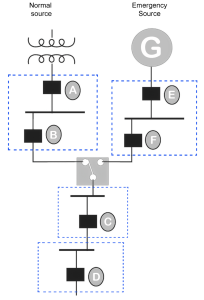How does NEC 2023 change selective coordination for emergency system OCPDs?
Overview
Effective coordination among overcurrent protective devices (OCPDs) is essential for promptly responding to faults when multiple OCPDs safeguard a single circuit or equipment. In the 2023 edition of the NEC, Section 700.32 underwent revisions to maintain selectivity among OCPDs, not only with upstream protection devices but also with those located downstream. Moreover, additional requirements were introduced to uphold selectivity among OCPDs during replacements and modifications within emergency systems. These adjustments enhance system integrity and safety, enabling the quick resolution of faults while maintaining continuous, uninterrupted service.
not only with upstream protection devices but also with those located downstream. Moreover, additional requirements were introduced to uphold selectivity among OCPDs during replacements and modifications within emergency systems. These adjustments enhance system integrity and safety, enabling the quick resolution of faults while maintaining continuous, uninterrupted service.
Applying the 2023 Code
Overcurrent protection devices (OCPDs) serve as vital components within electrical systems, interrupting the flow of electrical current when it exceeds safe thresholds in the event of a fault. These devices play a crucial role in protecting equipment, circuits, and individuals from potential overcurrent situations, which could result in equipment damage, electrical fires, and safety risks. Often, multiple OCPDs are employed within a single circuit to provide comprehensive protection for equipment or devices, offering localized protection for different circuit segments. In such scenarios, it is imperative to achieve effective coordination and selectivity among OCPDs. This approach allows downstream OCPDs to be the first to respond to faults nearest to them, thereby minimizing disruptions during fault occurrences.
In previous editions of the NEC, Section 700.32 required maintaining selectivity with supply-side OCPD devices within emergency systems. However, faults could cause reverse power flow situations, leading to fault currents flowing upstream. Earlier NEC editions did not provide guidance on selectivity for such scenarios, which could lead to possible damage to equipment. Consequently, the 2023 edition of the NEC was revised to incorporate the term “load-side” into all existing requirements for selective coordination.. This ensures that emergency system OCPDs are selective not only with upstream OCPDs but also with downstream OCPDs, providing comprehensive coverage in both directions. Additionally, two new requirements have been added: Subsection 700.32(B) pertains to the substitution of OCPD replacements in emergency systems, and Subsection 700.32(C) pertains to changes, expansions, or removals within the emergency system. These subsections mandate reevaluating selective coordination whenever OCPDs are replaced, or modifications occur within the emergency system.
What’s New for the 2023 NEC?
The table below presents a comparison between the 2020 NEC and the 2023 NEC regarding Section 700.32.
2020 NEC |
2023 NEC |
| 700.32 Selective Coordination
Emergency system(s) overcurrent devices shall be selectively coordinated with all supply-side overcurrent protective devices. Selective coordination shall be selected by a licensed professional engineer or other qualified persons engaged primarily in the design, installation, or maintenance of electrical systems. The selection shall be documented and made available to those authorized to design, install, inspect, maintain, and operate the system. Exception: Selective coordination shall not be required between two overcurrent devices located in series if no loads are connected in parallel with the downstream device. Informational Note: See Informational Note Figure 700.32 for an example of how emergency system overcurrent protective devices (OCPDs) selectively coordinate with all supply-side OCPDs. OCPD D selectively coordinates with OCPDs C, F, E, B, and A. OCPD C selectively coordinates with OCPDs F, E, B, and A. OCPD F selectively coordinates with OCPD E. OCPD B is not required to selectively coordinate with OCPD A because OCPD B is not an emergency system OCPD. |
700.32 Selective Coordination
(A) General Emergency system(s) overcurrent protective devices (OCPDs) shall be selectively coordinated with all supply-side and load-side OCPDs. Selective coordination shall be selected by a licensed professional engineer or other qualified persons engaged primarily in the design, installation, or maintenance of electrical systems. The selection shall be documented and made available to those authorized to design, install, inspect, maintain, and operate the system. (B) Replacements Where emergency system(s) OCPDs are replaced, they shall be reevaluated to ensure selective coordination is maintained with all supply-side and load-side OCPDs. (C) Modifications If modifications, additions, or deletions to the emergency system(s) occur, selective coordination of the emergency system(s) OCPDs with all supply-side and load-side OCPDs shall be reevaluated. Exception: Selective coordination shall not be required between two overcurrent devices located in series if no loads are connected in parallel with the downstream device. Informational Note: See Informational Note Figure 700.32(C) for an example of how emergency system OCPDs selectively coordinate with all supply-side OCPDs. OCPD D selectively coordinates with OCPDs C, F, E, B, and A. OCPD C selectively coordinates with OCPDs F, E, B, and A. OCPD F selectively coordinates with OCPD E. OCPD B is not required to selectively coordinate with OCPD A because OCPD B is not an emergency system OCPD. |
